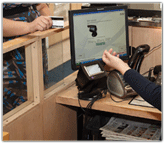 Systems catching on from Fortune 500s to Major League Baseball
Systems catching on from Fortune 500s to Major League Baseball
Security checks have become a fact of life for entrance to public buildings. As government agencies, corporations and schools struggle to keep track of individuals within their facilities at any point in time, a new breed of visitor management systems has risen to the top.
Though it may be more apparent today, visitor management is not a new function. For as long as organizations have sought to control access to facilities, there has been a need to manage visitors, vendors and other non-recurring guests. In the past, paper-based logs were managed by lobby attendants to ensure visitors had a legitimate reason to enter. Today’s electronic solutions automate these functions adding convenience and robust new security features to the process.
There are a number of different visitor management solutions on the market. Some are available as a part of enterprise-level solutions while others are off-the-shelf software products. Regardless of the solution, it should enable better control over access to facilities and automate the visitor entry and exit process. Upon check-in, a badge should be printed on-the-spot for use by the visitor. And after the fact, the electronic visitor logs should be able to be queried for reporting purposes.
The products can improve the first impression a visitor forms of the organization as well as improve both employee and visitors safety.
When evaluating visitor management solutions, there are many features to consider including ability to:
Baseball teams take a cut at visitor management
Two U.S. professional baseball teams–the Seattle Mariners and the Cleveland Indians–were trying to get a better handle on the people entering their facilities. “We wanted a more professional appearance at the front desk so we could track who’s coming in,” explains David R. Powell, senior director of information systems for the Cleveland Indians.
“We wanted to move away from handwritten ID stickers,” he says. “We were looking for a canned package.”
In addition to visitor tracking, the Indians also wanted to use the system with internal staff. “We needed a system to produce employee IDs because the one we were using in-house was developed some ten-years earlier and it was just too cumbersome,” explains Powell.
But the most important reason for the solution was the Indians’ need to track the vendors who visited the ball club often on a daily basis. They wanted to automate the paper-based sign in process being used to keep track of vendors.
With an electronic version, the Indians could easily check to see when a specific vendor–an electrician, for example–was last in. But more importantly, it enabled system operators to store individual records in a database and easily replicate a new badge the next time the vendor arrived.
“We have a lot of visitors and on any given day maybe 20 outside contractors. So we needed something to keep track of who was in the building at any one time,” Powell says. “In a two-week period we have about 300 visitor entries.”
The Indians chose Lobby Track, a visitor management solution from San Carlos, Calif.-based Jolly Technologies. “We found Jolly and we liked what we saw,” says Powell.
Named after its founder and CEO, Sandeep Jolly, the company got its start a decade ago producing bar code label products. In 2003 Jolly released its Print Studio solution to produce bar code labels, but the program also gained acceptance in the ID card market due to those same bar code capabilities. This led them to develop ID Flow and Lobby Track, the company’s people-tracking solution, in 2008.
Jolly’s biggest customers can be found in the defense industry, pharmaceuticals, oil and gas, retail, and now even baseball teams, says Kurt Bell, Jolly’s vice president of sales and marketing. The company is also seeing a need for its technology in other areas, including schools and college campuses.
For the Seattle Mariners, Lobby Track was the next logical step to secure its facilities. “We were already using ID Flow, Jolly’s badge-making program,” says Erik Hackmann, security supervisor for the Mariners. “We wanted something that would integrate with it.”
He explains that they wanted to use the badging database as part of the company’s host lookup. “When a visitor comes in he has to have a host, someone in the organization that is their sponsor. We have a database of people who are authorized to be hosts,” says Hackmann.
“You can look up the host and when an expected visitor arrives it can send an email that the visitor is here,” explains Bell.
Like the Indians, the Mariners consider everybody that’s not an employee to be a visitor. “The Mariners did 8,000 visitors last year,” Hackmann says.
“Right now, we’re in the off season so most are contractors who are doing all of our projects. We’re remodeling parts of the ballpark and everyone has to have a badge. We’re averaging between 40-50 a day,” says Hackmann.
Robust features take visitor management systems beyond badging solutions
Lobby Track has the ability to check visitors against terrorist watch lists and, particularly important for schools, sexual offender databases, Bell says.
Many organizations choose to produce guest badges using light-sensitive paper that darkens over time due to the chemical reaction produced by the thermal printing process used to produce the badges. This enables badges more than a day old to be visibly identified if they are reused for entry to facilities.
Most solutions enable both paper badges and plastic IDs to be produced. “If you’re going to be in seven times a year or more, we’ll issue a plastic badge, (but) temporary visitors get a paper badge,” says Powell.
Lobby Track automates data entry by scanning a guest’s driver license or business card. Information can be entered manually, if need be, and a Web cam is used to take a photo. “In most cases I take a new photo of everyone rather than use the driver license photo,” says Powell.
“We recently upgraded to the Enterprise version so we can run it here in Cleveland as well as at our spring training facility in Goodyear, Ariz.,” says Powell. Lobby Track’s Enterprise version is “faster and better suited to working in multiple locations,” he adds.
Adding applications and markets
Because of its tracking ability, Jolly’s software is useable in other venues, such as event tracking, lab access or even school attendance, says Bell.
While visitor management could work with universities, it’s not an easy market to crack. “The university market has been very difficult for visitor management, primarily because campuses are wide open,” says Bell. “To do it effectively you need to have a single entrance point, and students would have to have a noticeable ID in plain sight.”
But the K-12 market is different. “It’s more widely used,” says Bell. “Campuses aren’t as big and you have to get your badge at the office before proceeding on campus.” And it’s easy to distinguish adults from students, which is why K-12 students don’t need a visible badge.
Tracking software like Jolly’s is pretty much a behind-the-scenes product that, if it does its job, no one knows it’s even there. As the Indians’ Powell put it: “Visitor management isn’t the most high profile thing out there. It simply works so we can worry about the things that are more important.”




